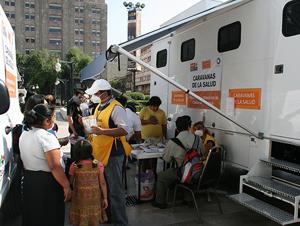H1N1 and public health
Mobile flu clinic in Mexico City (Image: Talea Miller, Online NewsHour, Creative Commons)
The following is not a full transcript; for full story, listen to audio.
One of the ongoing mysteries of the H1N1 influenza outbreak is why it killed 26 people in Mexico, but only two people right across the border in the U.S. Is it simply that the virus is less virulant now? Or can we learn something by looking at how each nation handles public health crises?
"The Takeaway" talks to Dr. Julio Frenk, former Mexican Minister of Health and now Dean of the Harvard School of Public Health, about the public health lessons learned from the H1N1 outbreak.
Dr. Frenk: "First of all what we’ve learned is that, no matter how prepared we are, we can never exactly predict when an epidemic, and where an epidemic, is going to occur. The world has been expecting an event like this at lease since 2003 after the SARS outbreak. We were due for an outbreak of human influenza, but all eyes were turned to Asia — everyone thought that’s where it was going to appear, and it appeared in the Americas."
He explains how the H1N1 virus is different: "Bear in mind that this virus is a new thing — it’s a new entity — it didn’t exist and what has made this … still a cause for concern, is the fact that it has sustained human-to-human transmission. This is the big difference with respect to the Avian flu outbreak that we saw in Asia since 2005 — those had very limited human-to-human transmission.
"The difference here is that it began to be transmitted, and it has proved to be sustained. And it has now spread to more than 20 countries. It is true that the epicenter is in Mexico, and especially in Mexico City, but the virus has been traveling around the world, and fortunately is less severe than we expected."
Dr. Frenk says a very refined surveillance system is needed to be able to detect a few cases of a difference kind of influenza against the backdrop of a regular flu season in a country of 110 million people, and he thinks in Mexico: "In my opinion the surveillance system did work because they detected the anomaly that most of the deaths were occurring in healthy, young adults, which is not what happens with the regular flu. And that’s what set the alarms off, and set in motion the steps it took within a few weeks, to the full genetic sequencing and the realization that we were in the face of a whole new virus."
He rates the communication around the H1N1 outbreak: "My scorecard on this case is, I think the alarm level was raised enough that the world reacted, and probably the reason we’re not seeing many more cases than this is because countries have responded. I think in the case of Mexico, it was particularly valuable that the President, Mr. Felipe Calderon, personally headed the response to the emergency, because that sends a signal to the population that this is serious."
"The Takeaway" is a national morning news program, delivering the news and analysis you need to catch up, start your day, and prepare for what’s ahead. The show is a co-production of WNYC and PRI, in editorial collaboration with the BBC, The New York Times Radio, and WGBH.
